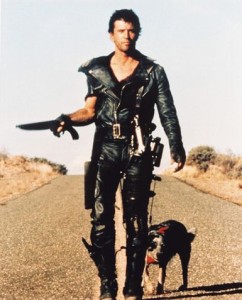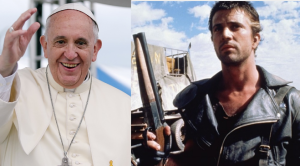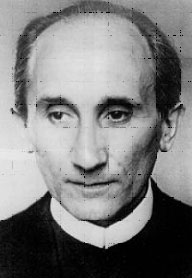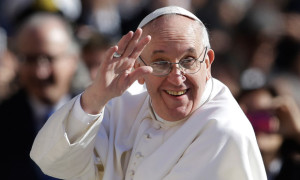With its focal point being material progress, liberal modernity fixates so much on efficient means that we forget the basic ends of economic development and democratization: the human being.
Mad Max, the dystopian film series by George Miller about the title Australian road warrior, may not at first seem the most insightful commentary on society. Nor with its hyperbolic B-Film road battles scenes would it seem an apt comparison to the most recent papal encyclical by Pope Francis, Laudato Si. Yet both Mad Max and Laudato Si converge in presenting an apocalyptic vision that connects environmental collapse with moral and spiritual degeneration.

Both Mad Max and Laudato Si are both concerned with the end of society. Mad Max shows the ruins of Australia after a nuclear war; Pope Francis speaks about the moral and physical dangers of climate change: “Doomsday predictions can no longer be met with irony or disdain.” Mad Max shows what is left after modern society – what one may call “the democratic social state” – is wiped away. Laudato Si is a criticism of the democratic social state and its upcoming catastrophe. Yet take away the apocalyptism from both, and what remains is a vivid presentation of the postmodern social state of the West – a cultural amnesia of what we call home. Mad Max and Laudato Si both reveal Western societies as amnesiac about the basis for a common life — specifically, our cultural inheritance, and the innate purposes of human nature or what is called natural law — among the living and between the living and the dead.
We live in a spiritual desert. It takes figures like Mad Max to rescue us, yet in a democratic social state we have no aristocrats.
The democratic social state is a term Alexis de Tocqueville uses to describe our industrial and commercial societies after the American and French Revolutions. The word democracy is not enough to describe this new type of regime because democratic republics like Athens and Rome were still hierarchical and aristocratic in principle. Instead, this new regime is a social state dedicated to the happiness of the greatest number. This state, unlike every other preceding it, is premised on a passion for equality of material conditions.
Aristocracies possessed a few rare individuals, among the weak citizens and domestics (women, children, servants, and slaves), who could achieve great ends without the aid of others as equals. They could command. Yet, while “Aristocracy has made of all citizens a long chain that went from the peasant up to the king; democracy breaks the chain and sets each link apart,” Tocqueville writes in Democracy in America. It might be that Max could direct a whole society in a prior age.
Instead, we in modern democracies are individually weak and require others to achieve our ends (like building a school or managing a church) through institutions (like a school board or parish membership). Free institutions aid democracies by drawing individuals away from private and material interests – local government involves men and women in society and religion draws the soul from commerce to God and community. Filling the space between the individual and the state, institutions or associations perform what great individuals did in previous ages. They are the modern aristocrats.
The reason for this service is that the democratic social state encourages individuals to pursue material equality and become isolated from concrete communities and public life– “it constantly leads him back toward himself alone and threatens finally to confine him wholly in the solitude of his own heart.” Implied, Tocqueville says, is that a “people among whom particular persons lost the power of doing great things in isolation, without acquiring the ability to produce them in common, would soon return to barbarism.” And barbarism the Mad Max series depicts, along with those efforts by Max to save the weak and threatened.
Appearing in four installments – Mad Max (1979), Mad Max 2: The Road Warrior (1981), Mad Max: Beyond the Thunderdome (1985), and Mad Max: Fury Road (2015) – the character Mad Max “Rockatansky” is played by Mel Gibson in the first three and Tom Hardy in the latest one. In the first film, Max is an Australian highway cop who takes on a cultic biker gang as his country politically decays. The fight against the gang costs him his family and friends, and he seeks vengeance. In the latter three films, the setting is the remnant human beings in Australia after a nuclear war lays waste to cities and societies. Here, Max uses his road cop skills to become a wandering road warrior, often running into and aiding various groups fighting to survive. Max rescues a tribe of nuclear survivors going north in The Road Warrior, a group of orphans in Beyond the Thunderdome, and escaping sex slaves in Fury Road– those who are helpless if isolated, and require this leader who disappears as quickly as he appears.
It might be said that Mad Max recalls an aristocratic warrior, which our social state has eliminated, who could achieve great things by himself or command without peers: the warrior Achilles, Saint Joan of Arc, or William Pitt the Younger who was the British Prime Minister at age 24. But when wars are waged “for a tank of juice,” the narrator of Road Warrior begins, “ordinary men were battered and smashed – men like Max, the warrior Max.” He “wandered out into the wasteland” and “learned to live again.”
For instance, Road Warrior features a small fort occupied by survivors who still try to retain the habits of civilization, and they are accosted by a quasi-religious high octane warrior tribe. In the post-nuclear war world of Mad Max, people can live only by resorting to traditional communities, humane or barbaric. As the film’s narrator opens, “Only those mobile enough to scavenge, brutal enough to pillage, would survive.” So Max, in the truest meaning of “a road film”, helps the mobile men and women escape those brutal enough to pillage.
Each of us, then, is a Max in a world gone mad, a physical and cultural orphan.
Max speaks very little, travels alone, and when he acts, acts greatly. In this sense, he is a paradox: the individualist democrat who, when morally called, becomes an aristocrat sustaining what institutions and communities are left against those “strong enough to pillage.” Against this figure, the Mad Max series portrays the utmost potential for barbarism. Yet it can be taken as an apt representation of our postmodern and post-Christian social state. We live in a spiritual desert in which institutions of family, religion, provincial government, and general civil associations decline, the scripts that these communities embody are lost, and individuals are left adrift and wandering, like Mad Max, “out into a wasteland.” It takes figures like Mad Max to rescue us, yet in a democratic social state we have no aristocrats.
Fury Road pits two groups against each other. We begin with a patriarchal tribe whose neo-Nordic religion is based on Valhalla, auto mechanics, and worship of a leader who holds the water, Immortan Joe. His ‘war boys’ are brainwashed fighters on cars who aspire to be “witnessed” (incidentally, “witness” in Latin means “martyr”) in kamikaze martyrdom to live after death riding in paradise “shiny and chrome.” Its hundreds of young boys work in factories – the Citadel – storing the private water of Immortan Joe. The water lord’s young “prized breeders” escape with the driver of the old tanker, Imperator Furiosa (Charlize Theron), whose job is to get fuel. They team up with Max, and as they are chased by legions of war boys, join forces with Furiosa’s old tribe—an elder matriarchy known as “The Mothers” who are dying out. Max and the young and old women take on Immortan Joe.
Analyzing the film’s sex politics is piece unto itself; but consider here Max’s solution in Fury Road for the ragtag of escaped women, elder matriarchs, Furiosa, and an escaped road warrior. He says they can drive on motorcycles for “a hundred and sixty days’ ride that way” in the Australian desert, where “there’s nothing but salt” or a return to fight Immortan Joe. “At least that way,” Max says pointing to the Citadel, “we might be able to… together… come across some kind of redemption.” They must team together to find “some redemption.” That, as the escaped war boy says, sounds like “hope.”
Alissa Wilkinson suggests that Mad Max “gives a thoroughly postmodern answer” to the problem of modern society. “Oppression,” we postmoderns believe, “is not countered and defeated by a stronger alternative religion. There’s no better regime. In our dystopias, institutions are just bad.” The alternative is that “our stories are about individual people banding together in hopeless defiance of towering tyrants” without Valhallas or good governments. Solidarity among individuals needs no enduring structures.
If that interpretation is true, Wilkinson suggests, and “if Mad Max is any indication, [then] those who believe in institutions, like those who feel called to build churches, are fighting an uphill battle in convincing many young Americans that they aren’t merely out to impose another kind of agenda upon them.” This skepticism of institutions is dangerous because without these civil associations, democrats cannot achieve anything. Still, Fury Road points to the problem – our common lack of knowing how to associate with each other. We have language of global citizenship, multiculturalism, and all manner of abstract signifiers to try to understand individuals without embodied contexts and roots.
In contrast, Pope Francis subtitles his encyclical, which concerns our stewardship of the earth, On Care for our Common Home—something that is ours, a concrete and specific place for which we are accountable.
An encyclical is a Papal letter written by the Bishop of Rome, addressed to all the bishops of the Catholic Church and intended for all Catholics, ecclesial and lay. They concern matters of faith and morality, and provide the basis for what is called Catholic Social Teaching. Two principles of Catholic Social Teaching are Solidarity and Subsidiarity. As found in Aristotle and St. Paul, Solidarity means that all our actions are directed towards the common good of all, as each of us depends on all in a polity. Subsidiarity means, complimentarily, that due to requirements of prudence and justice, what can be done at the lowest level of society should be done at the lowest level. Pope Francis draws from both of these.
While not without its weaknesses, this encyclical by Pope Francis explores environmental questions with the language of the home and the etymology of “economy”—the governance of the household. The notion of what is “common” recalls Solidarity and the notion of our “home” recalls subsidiarity. As Alan Jacobs describes, “Such domestic language is a powerful means of fighting the abstracting effects of any attempt to ‘think globally.’ Francis seems to be saying that if you want to act globally, you should think locally: think of the earth as your home, one you share with others to whom you are accountable.”
For Francis, a world reconversion to Christ implies fighting for the place in which you live, are rooted, and may make a home. Max wanders from place to place, without roots. In our ‘globalized’ world, postmodern democratic excesses make roots progressively more significant. Each of us, then, is a Max in a world gone mad, a physical and cultural orphan.
Putting momentarily aside his specific policy recommendations, the Pope’s encyclical, like Fury Road, connects ecological destruction, ravaging of fleeting resources, and civilizational breakdown with our own moral degeneration. We can choose to be either stewards or exploiters of our earth – derives from our actual character, habituated by how we treat our fellow human creatures and give due worship to our Creator.
Now, Tocqueville says the democratic state makes “each man forget his ancestors,” and “hides from him and separates him from his contemporaries.”
In particular, Pope Francis argues that the dual denial of fundamental moral principles that underlie all economic, cultural, and political questions results in a “throwaway culture.” As we consume and throw away our material goods, we might well consume and throw away people. “When we fail to acknowledge as part of reality the worth of a poor person, a human embryo, a person with disabilities,” he writes, “it becomes difficult to hear the cry of nature itself; everything is connected.”
He contrasts the “technocratic paradigm,” underlying this “throwaway culture,” with the concept of an “integral ecology.” The first is the singular vision that any problem must be first and foremost addressed as a technological problem, only requiring the proper deconstruction and reconstruction, conceptually and physically, of the object observed. Yet technology, when “presented as the only way of solving these problems,” is “incapable of seeing the mysterious network of relations between things and so sometimes solves one problem only to create others,” he writes.
This “mysterious network of relations between things” is an “integral ecology” – as there is an order of the natural world from which the human species emerged and upon which it subsists, there is a moral order (a human ecology or, more traditionally, natural law) rooted in our rational, social, and biological nature that governs the world of human relations, from everyday interaction to issues of political economy. A dual indifference to environmental and human breakdown mirrors the interconnected order of human life, one morally governed by its own natural laws through reason and conscience. That order is metaphysically subsumed into the supernatural order, and any discord between the human and the supernatural creates disorder with the ecologies of man and the rest of creation. Both environmental and cultural damage must be spiritually redeemed.

Pope Francis often cites Romano Guardini, an early twentieth century Italian-born, German Catholic theologian. Guardini believed modern society was fundamentally amiss in its mediated disruption from the natural order and thus an internal disruption with ourselves. With its focal point being material progress, liberal modernity fixates so much on efficient means that we forget the basic ends of economic development and democratization: the human being. For Guardini, Matthew Schmitz explains, “What actually motivates calls for managing resources according to “statistics” and “theory” is not a practical concern for the best outcome so much as a spiritual desire to impose one’s will on others” – in other words, the technocratic paradigm.
The connection to the latest installment, Fury Road, is that the battles for scarce resources are an apocalyptism of individual wills forced upon wills, similar to what Guardini and the Pope imagine of technocratic thinking. There is no known authority in such a society to morally and politically deliberate together and act in common as equals. Take away the visage of the apocalyptism and we see a society that has forgotten what the world is for, a society without memory of its home and the communities tethering it together. [Indeed, Fury Road repeatedly asks, “Who Killed the World?”] Save exploitation by a demagogic and mechanical bureaucracy or mere rag-tag individuals resisting oppression, we find no in-between of civic institutions that function as aristocrats but are made of democrats.
One plausible critique of Laudato Si is that, like the Mad Max series, its apocalyptism clouds a future not of utter collapse (nor the alternative dynamist future of unending prosperity), but something more insidious. Instead, New York Times columnist Ross Douthat suggests “a kind of stagnationist position, a sustainable decadence, in which the issues Pope Francis identifies percolate without reaching a world-altering boil.” Douthat argues our future could be an affordable decadence in which continued growing wealth permits such things as more breakdown of families, removal of local governance, and degradation of culture and ecosystem. Our median household income can rise in the last several decades while social capital in America has steadily deteriorated since the 60s, for instance. We are seeing the retreat of civil associations for much of American society, the institutions necessary for us in a democratic social state. Yet our democratic culture remains amnesiac about how to ever reverse the stagnation and the necessity to return to the permanent things of human life. The End is kept continually at bay and thus necessity demands nothing of us. Rather than “fear that the particular evils of our age can’t last,” Douthat writes, we must face the possible “fear that actually, they can.”
Interestingly, the last three Mad Max films are tales retold to future generations, accounts in which Max appears as a saving ghost to be remembered. Those who survived the nuclear war are dying out (specifically, the Mothers), and with them memories of the old world. The result is that history is beginning again. The end of Fury Road is an epigram by ‘The First History Man’ who writes, “Where must we go, we who wander this wasteland, in search of our better selves.” This First History Man is telling about Max for the very first time, a retrospective glance at the origins of civilization renewal.

Yet this story is being retold. In Beyond the Thunderdome, Max is banished from a city known as Bartertown. Bartertown is partly ruled by a matriarch, Aunty Entity (played by Tina Turner), who uses a gladiatorial battle cage – called “the Thunderdome” – as a miniature Colosseum to politically and religiously unite the city and rebuild civilization with the killing of a scapegoat. After being banished from Bartertown, Max finds himself having to save a group of orphans whose parents died in a plane crash. The children first greet him with a narrative rhyme prophesizing a mythic plane captain coming to rescue them. The story then takes Max through a road chase away from Bartertown to rescue what will become a tribe that resettles the ruins of Sydney. The final scene returns to tribal tradition, with a young mother and leader who teaches her son and other children a new rhyme that recalls the first.
It’s the tell of us all, and…what you hears today you gotta tell the newborn tomorrow. I’s lookin’ behind us now into history back…and we knows now: finding the trick of what’s been and lost ain’t no easy ride, but that’s our trek … Still in all, every night we does the tell so that we ‘member who we was and where we came from. But most of all we ‘members the man who finded us, him that came a-salvage. And we lights the city, not just for him, but for all of them that are still out there. ‘Cause we knows there’ll come a night when they sees the distant light and they’ll be comin’ home.
This tale mirrors a kind of liturgy found in Catholic and other Christian services. In fact, we might read Max as a Christ-figure come as a would-be messiah guiding those lost in the wilderness. But Max leaves before he can take political power. And after leaving, Max is recounted as a ‘saviour’ from generation to generation. The tribe lights its city at night to aid anyone struggling to find the institutions without which they cannot survive for long – anywhere to call home. The city is a culture orphaned from the roots of its civilization. Some buildings remain in this wasteland as beacons waiting for those stragglers needing to make a common home.
Now, Tocqueville says the democratic state makes “each man forget his ancestors,” and “hides from him and separates him from his contemporaries.” So the individual cherishes the free institutions that used to be taken for granted by most Americans. Now, rebuilding social life to sustain us amidst decadence is like renovating and lighting abandoned cities in a wasteland and making them our common home.
The civilizational destruction of these films aptly represent our lives in the postmodern west—social life in a wasteland in search of our better selves. We may not have the aristocrats like Mad Max, but like him we have the opportunity to sustain institutions that outlast stagnation. For if not, how else can we hope for these tales to be told by future generations? Mad Max may not know from where, but Pope Francis may know from Whom.
Ryan Shinkel may be reached at theshink@umich.edu.

